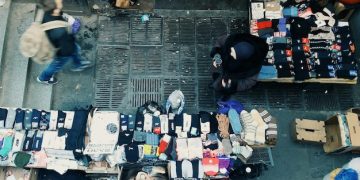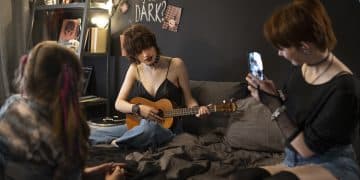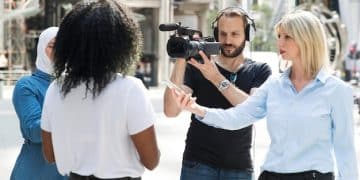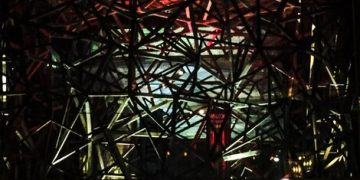Beyond the Stage: Alternative Performance Venues for Emerging Artists in the US
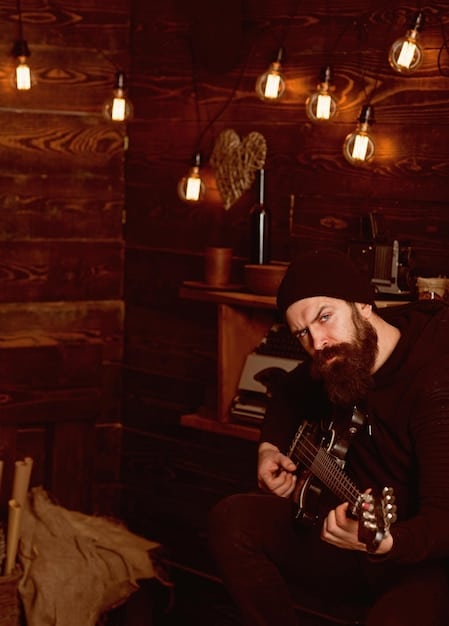
Emerging artists in the US can find innovative performance opportunities beyond traditional venues by exploring unconventional spaces like art galleries, pop-up events, community centers, and digital platforms, each offering unique engagement and exposure avenues.
For aspiring US artists, the path to gaining recognition often involves securing performance slots. However, the traditional stage can sometimes feel like a distant dream. This is where the concept of Beyond the Stage: Alternative Performance Venues for Emerging Artists in the US becomes pivotal, offering diverse and accessible platforms for showcasing talent and connecting with new audiences.
The Evolution of Performance Spaces for Emerging Talent
The landscape for performing artists is constantly shifting, moving beyond the conventional concert halls and dedicated theaters. This evolution is driven by various factors, including the rising costs of traditional venues, the desire for more intimate and unique audience experiences, and the increasing flexibility offered by digital tools. For emerging artists, understanding this evolving ecosystem is crucial for identifying opportunities that align with their artistic vision and financial realities. The modern artist needs to think creatively about where and how they can connect with their audience. This often means looking at spaces that were not originally designed for performances but can be easily adapted.
This shift isn’t just about finding cheaper options; it’s about redefining what a “performance venue” truly is. It emphasizes community engagement, adaptability, and the ability to create memorable experiences in unexpected settings. Artists are no longer confined by the physical limitations of a traditional stage, opening up endless possibilities for creative expression and audience interaction.
The Shift Towards Experiential Art
One of the primary drivers of this evolution is the growing demand for experiential art. Audiences today are often looking for more than just a performance; they want an immersive experience. This has led to a boom in venues that offer unique atmospheres, allowing artists to connect with their fans on a deeper, more personal level. These new spaces provide a blank canvas for artists to innovate, from intimate acoustic sessions in coffee shops to large-scale multimedia installations in industrial warehouses.
- Cost-effectiveness: Alternative venues often come with lower rental fees, making them more accessible for artists with limited budgets.
- Audience reach: Performing in non-traditional spaces can attract diverse audiences who might not typically attend formal concerts.
- Artistic freedom: These venues often offer greater flexibility in terms of setup, sound, and artistic expression.
- Community building: Engaging with local businesses and community spaces can foster stronger ties and support networks.
The embrace of alternative venues signifies a broader cultural trend towards decentralizing art and making it more accessible to everyone. It empowers emerging artists to take control of their careers, experiment with new formats, and build a dedicated following outside the traditional industry gatekeepers. This DIY approach not only saves money but also fosters a sense of authenticity that resonates strongly with today’s audiences.
Unconventional Spaces: Galleries, Cafes, and Bookstores
Art galleries, coffee shops, and bookstores are increasingly recognizing their potential as vibrant alternative performance venues. These spaces inherently attract a demographically diverse audience, often comprising individuals who appreciate culture and are open to new experiences. For an emerging artist, performing in such an environment offers numerous advantages, blending artistic expression with a casual, inviting atmosphere. Imagine a poet reading their latest work surrounded by contemporary art, or a singer-songwriter performing an acoustic set amidst shelves of books; these settings provide an intimate connection with the audience that formal venues often lack.
These venues thrive on creativity and community, making them natural fits for artists seeking to explore beyond the traditional stage. They offer a unique blend of cultural immersion and commercial activity, allowing artists to tap into existing foot traffic while providing patrons with enhanced experiences. Building relationships with these establishments is key for artists looking to secure regular performance opportunities. This involves demonstrating professionalism, understanding the venue’s vibe, and offering a performance that complements its existing atmosphere.
Benefits for Both Artists and Venues
The synergy between artists and these unconventional venues creates a win-win situation. Artists gain access to built-in audiences and exposure without the high costs associated with music venues, while the establishments enhance their ambiance, attract new customers, and diversify their cultural offerings. A local bookstore, for example, might see an uptick in sales during an open mic night, as attendees browse books before or after performances. Similarly, a cafe hosting live music becomes a destination, not just a place for coffee.
This symbiotic relationship demonstrates a conscious effort by both parties to cultivate a richer cultural environment within their communities. It’s about recognizing that art can flourish in unexpected places, reaching audiences who might not actively seek out traditional performance spaces but are open to encountering it during their daily routines.
- Art Galleries: Ideal for visual performances, experimental music, and spoken word, often pairing well with existing exhibitions.
- Coffee Shops: Perfect for acoustic sets, poetry readings, and open mic nights, offering a relaxed and intimate setting.
- Bookstores: Excellent for literary events, live readings, and folk music, attracting an audience that values storytelling and quiet contemplation.
- Boutique Stores: Emerging as unique spaces for fashion shows, pop-up concerts, and art installations, drawing a specific, often trend-conscious, crowd.
Collaborating with owners of these spaces requires careful planning and mutual respect. Artists should approach them with clear proposals, detailing their needs and how their performance will benefit the venue. Establishing a good rapport can lead to recurring opportunities and word-of-mouth recommendations within the local community, building a sustainable performance circuit for emerging talent.
Beyond the Walls: Pop-Up Events and Public Spaces
The allure of pop-up events and public spaces lies in their transient nature and accessibility, offering a dynamic alternative to fixed venues. Pop-ups, by their very definition, create a sense of urgency and exclusivity, drawing crowds eager to witness something unique and temporary. These can range from a spontaneous street performance to a carefully orchestrated multi-day artistic installation in a vacant retail space. Similarly, public spaces—parks, plazas, community gardens—offer inherent stages for artists, allowing them to engage directly with the general public, often without the barriers of ticket prices or formal reservation. This direct interaction can be incredibly powerful for emerging artists seeking to build a grassroots following and make their art accessible to everyone.
Utilizing these spaces requires a different kind of planning, often involving permits, crowd management, and an understanding of local regulations. However, the reward is often a highly impactful and memorable performance that resonates deeply within the community. The flexibility these spaces offer allows for creative experimentation, enabling artists to rethink traditional performance formats and engage with their surroundings in innovative ways. This approach also democratizes art, bringing it directly to the people instead of expecting them to seek it out in established cultural institutions.
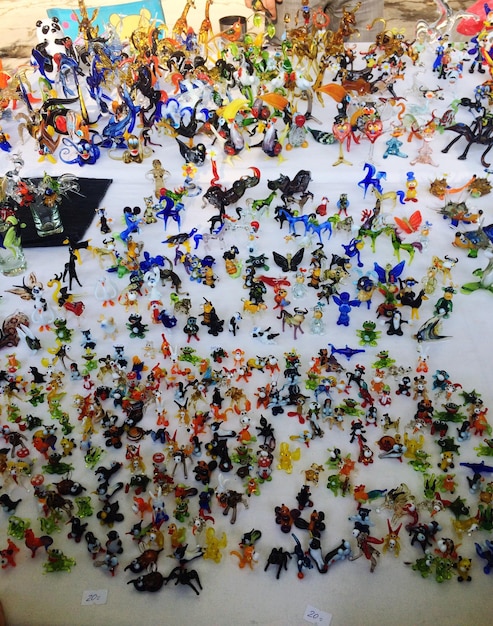
Engaging the Community Through Unconventional Means
Public spaces are inherently social, and converting them into performance venues fosters community engagement on multiple levels. Local residents might stumble upon a performance during their daily errands, leading to unexpected discovery and genuine appreciation. Artists, in turn, gain immediate feedback and the opportunity to interact with a diverse audience that might not otherwise encounter their work. This informal setting often strips away the formality of traditional performances, allowing for a more authentic and raw artistic expression.
- Parks and Plazas: Excellent for musical performances, dance, theater, and impromptu art installations, subject to local regulations.
- Street Corners and Sidewalks: Ideal for busking, spoken word, and short, engaging performances that capture passersby’s attention.
- Vacant Retail Spaces: Can be transformed into temporary galleries, black box theaters, or immersive art experiences.
- Community Gardens: Offer a serene and natural backdrop for acoustic music, storytelling, and intimate performances.
Navigating the legalities of performing in public spaces is crucial. Artists should research local permitting requirements, noise ordinances, and any other regulations that might apply. Collaborating with local community organizations or city cultural departments can simplify this process and open doors to more structured opportunities. The key is to be respectful of the space and its existing users while bringing a fresh artistic perspective.
The Digital Frontier: Online Platforms and Virtual Venues
While physical alternative venues offer tangible experiences, the digital frontier has emerged as an equally vital space for emerging artists, providing unparalleled reach and accessibility. Online platforms transcend geographical limitations, enabling artists to connect with global audiences from the comfort of their own studios. This encompasses everything from live-streamed concerts on social media to interactive virtual reality experiences and dedicated online performance spaces. The internet effectively acts as a boundless stage, offering diverse formats for showcasing talent, from short-form video content to full-length virtual performances. This digital shift has been accelerated by recent global events, proving its resilience and necessity in the art world.
For an emerging artist, leveraging these digital tools is no longer optional; it’s a fundamental aspect of career development. It allows for continuous engagement with fans, collection of direct feedback, and immediate monetization opportunities through platforms that support tips, subscriptions, or digital merchandise. Furthermore, the data analytics available through online platforms can provide invaluable insights into audience demographics and engagement patterns, helping artists tailor their content and marketing strategies more effectively.
Harnessing Technology for Artistic Expression
The beauty of virtual venues lies in their capacity for innovation. Artists can experiment with augmented reality, virtual sets, and interactive elements that are impossible in physical spaces. This opens up new avenues for storytelling and immersive experiences. Imagine a virtual concert where audience members can choose their viewpoint or interact with visual effects in real-time. These possibilities push the boundaries of what a “performance” can be, allowing artists to create truly unique and memorable experiences. The digital realm also offers a low-cost entry point for experimentation, reducing the financial risk associated with traditional productions.
- Live-streaming Platforms (e.g., Twitch, YouTube Live): Best for real-time performances, Q&A sessions, and building an engaged online community.
- Social Media (e.g., Instagram, TikTok): Ideal for short, engaging content, behind-the-scenes glimpses, and direct artist-fan interaction.
- Dedicated Virtual Reality Spaces (e.g., VRChat, Decentraland): Offer immersive, interactive performance environments for cutting-edge artists.
- Podcast Platforms: Excellent for spoken word, audio dramas, and musical storytelling, reaching an auditory-focused audience.
While the digital frontier offers immense opportunities, it also presents challenges, such as standing out in a crowded online space and maintaining authentic connections with a virtual audience. Artists need to develop strong digital marketing skills, understand algorithm dynamics, and continuously adapt their content to new trends. Building a robust online presence is a marathon, not a sprint, requiring consistent effort and creative differentiation. The key is to find a niche and cultivate a loyal following by delivering high-quality, authentic content that resonates with your target audience.
Grassroots and Community-Led Initiatives
The heart of many alternative performance movements beats within grassroots and community-led initiatives. These are often driven by passionate individuals or small groups dedicated to fostering local talent and enriching their neighborhoods through art. Such initiatives typically include open mic nights at local cafes, DIY concert series hosted in backyards or basements, and collaborative events organized by artist collectives. Unlike mainstream venues, these spaces prioritize accessibility, inclusivity, and creative freedom over commercial viability, though many strive for sustainability. They embody a spirit of mutual support, offering emerging artists a low-pressure environment to develop their craft, experiment with new material, and connect with a supportive audience.
These initiatives often grow organically, responding directly to the needs and desires of the local artist community. They are characterized by a strong sense of ownership and participation, where artists often take on multiple roles, from performer to organizer to promoter. This hands-on approach allows for incredible flexibility and responsiveness, enabling quick adaptation to emerging trends or local needs. They also serve as vital incubators for new talent, providing a stepping stone for artists to gain experience and confidence before pursuing larger opportunities.
The Power of Local Networks
The strength of grassroots initiatives lies in their local networks. Artists benefit from direct connections with fellow creators, potential collaborators, and a dedicated local fanbase. This close-knit community often provides invaluable support, from sharing resources and equipment to offering mentorship and performance feedback. Word-of-mouth marketing is particularly effective in these circles, as enthusiastic attendees spread the word about compelling performances. These networks act as informal artistic ecosystems, nurturing talent from the ground up and ensuring a continuous flow of creative energy within the community.
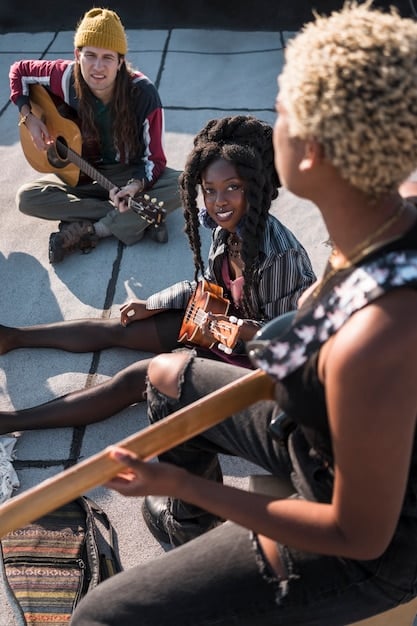
- Community Centers: Often have multipurpose rooms suitable for workshops, rehearsals, and small performances, benefiting from existing community infrastructure.
- Local Churches/Synagogues: Many offer spaces for a variety of community events, including concerts, often with good acoustics.
- Neighborhood Basements/Garages: Can be converted into impromptu venues for intimate, raw performances, popular in urban arts scenes.
- Artist Collectives: Groups that pool resources and share spaces, often hosting collaborative events and curated showcases.
Engaging with these initiatives requires proactive participation. Artists should seek out local arts organizations, attend open mics, and participate in community events to become integrated into the scene. Building genuine relationships and contributing to the collective good will not only open doors to performance opportunities but also foster personal and artistic growth. This collaborative spirit is what truly empowers emerging artists to thrive outside the traditional art industry structures.
Navigating Challenges and Maximizing Opportunities
While alternative performance venues present a wealth of opportunities for emerging artists, they are not without their challenges. Navigating these spaces effectively requires a blend of creativity, strategic thinking, and resilience. One primary challenge is often logistics: securing necessary permits for public spaces, ensuring adequate sound and lighting in unconventional settings, and managing crowds in informal environments. Beyond the practicalities, artists must also contend with the task of promoting their events to a dispersed audience, as these venues often lack the established marketing machinery of traditional theaters or music halls. Overcoming these hurdles demands a proactive and adaptable approach from artists looking to truly thrive “beyond the stage.”
However, embedded within these challenges are significant opportunities for growth and innovation. The very nature of alternative venues pushes artists to be more resourceful, think outside the box, and develop a more direct relationship with their audience. This hands-on experience can be invaluable for long-term career development. By embracing these challenges, artists can build unique identities and forge strong community connections that will serve them well throughout their careers.
Strategies for Success in Alternative Spaces
- Networking: Actively connect with other artists, venue owners, and community organizers. Word-of-mouth is crucial in these informal networks.
- Promotion: Utilize social media, local community boards, word-of-mouth, and partnerships with venues to spread the word about your performances. Think creatively about how to reach audiences who frequent these spaces.
- Flexibility: Be adaptable to different acoustic environments, audience sizes, and technical limitations. Be prepared to perform with minimal equipment if necessary.
- Professionalism: Even in informal settings, maintaining a professional demeanor, punctuality, and clear communication builds trust and leads to repeat opportunities.
- Legal and Safety Considerations: Always research local regulations regarding public performances or temporary use of commercial spaces. Prioritize audience and performer safety.
Maximizing opportunities also involves developing a strong value proposition for the venue. How will your performance enhance their space, attract new customers, or foster community? Clearly articulating these benefits can make a significant difference in securing performance slots. Furthermore, consider embracing a multi-faceted approach, combining performances in physical alternative venues with a robust online presence to broaden your reach and engagement. The synergy between physical and digital spaces can create a powerful ecosystem for growth.
The Future Landscape of Artist Performance: Innovation and Accessibility
The future landscape for artist performance is poised for continued innovation, driven by technological advancements, evolving audience expectations, and a growing emphasis on accessibility. Traditional performance models are being continually disrupted, paving the way for more dynamic, interactive, and inclusive experiences. The trend towards alternative venues is not merely a temporary adjustment but a fundamental shift in how artists connect with their audience and how art is consumed. We can anticipate an increased blurring of lines between physical and virtual spaces, with hybrid events becoming commonplace, offering both live and streamed components. This evolution democratizes access to art, allowing artists from diverse backgrounds and locations to share their voices without the traditional barriers.
Moreover, there will likely be a greater integration of immersive technologies, such as augmented reality (AR) and virtual reality (VR), within live performances, even in unconventional settings. Imagine a live band performing in a warehouse while AR overlays project reactive visuals that transform the space. This fusion of art forms creates entirely new sensory experiences for the audience. The emphasis will also be on sustainability and community impact, with many alternative venues and events designed to minimize environmental footprint and actively contribute to local social well-being.
Emerging Trends and What to Expect
- Interactive Installations: Audiences will become increasingly active participants rather than passive observers, influencing the performance or contributing to an art piece.
- Hyper-Localized Events: More emphasis on neighborhood-specific performances, fostering stronger community bonds and showcasing local talent in targeted ways.
- Subscription-Based Micro-Venues: Small, curated spaces opening up for members or subscribers, offering exclusive performances and intimate artistic experiences.
- AI-Assisted Creativity: Artists may begin using AI tools to create new soundscapes, visual effects, or even interactive narratives within their performances, enhancing the overall experience.
Ultimately, the future of artist performance will be characterized by extreme adaptability and a relentless pursuit of authentic connection. Artists who can fluidly navigate diverse platforms, embrace new technologies, and consistently offer engaging and meaningful experiences will be the ones who thrive. The “stage” will be everywhere, and its definition will be limited only by the artist’s imagination. This opens up unprecedented opportunities for emerging artists to carve out their own unique paths, build dedicated fanbases, and redefine what it means to be a performer in the modern era.
| Key Point | Brief Description |
|---|---|
| 🎨 Unconventional Spaces | Art galleries, cafes, and bookstores offer intimate, accessible platforms for performances. |
| 📍 Pop-Up & Public Venues | Temporary events and public areas provide dynamic, direct audience engagement. |
| 💻 Digital Platforms | Online streaming and virtual realities offer global reach and innovative artistic expression. |
| 🌱 Grassroots Initiatives | Community-led efforts nurture local talent and provide supportive environments. |
Frequently Asked Questions
▼
Alternative venues offer numerous benefits, including lower costs compared to traditional stages, increased artistic freedom, the opportunity to appeal to diverse audiences, and a chance to build stronger community connections. They allow artists to experiment with their craft and reach people in unexpected, intimate settings.
▼
Artists can find alternative spaces by networking with local businesses, community organizations, and fellow artists. Directly approaching cafes, galleries, or retail stores with a tailored proposal showing how their performance benefits the venue often works. Online directories and local arts councils can also provide leads.
▼
Yes, performing in public spaces often requires considering local laws regarding permits, noise ordinances, and crowd management. Artists should research specific city or county regulations to ensure compliance. Collaborating with city cultural departments or community groups can help smooth the process and achieve necessary approvals.
▼
Digital platforms can significantly complement live performances by extending an artist’s reach globally, creating a continuous content stream, and offering interactive experiences impossible in physical spaces. They can also substitute live shows by providing a low-cost, accessible stage for artists to build an audience and experiment with new formats without geographical limits.
▼
Artistic expressions that thrive in alternative venues are often those that lend themselves to intimacy, adaptability, and direct audience interaction. This includes acoustic music, spoken word, poetry readings, experimental theater, pop-up installations, and any performance that benefits from a unique, immersive, or less formal setting, fostering close connections.
Conclusion
The journey for emerging artists in the US is increasingly defined by their ability to look beyond the stage, embracing a diverse array of alternative performance venues. From the intimate settings of art galleries and coffee shops to the dynamic engagement of pop-up events and the boundless reach of digital platforms, these spaces are redefining how art is created, shared, and consumed. While challenges exist, the opportunities for creative expression, community building, and direct audience connection are immense. By cultivating adaptability, leveraging local networks, and embracing technological innovation, emerging artists can carve out unique and sustainable paths, ensuring their voices are heard and their stories are told in an evolving artistic landscape.

